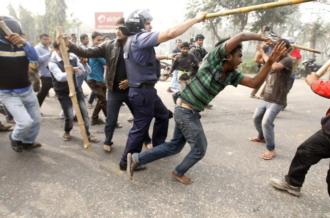Country moves to self-fund the Padma bridge, hoping to boost economy and national pride amid paralysing protests. |
|
Economists say a bridge over the Padma river could boost GDP by 1 percent a year [Shahnoor Habib Munmun/CC]
|
| Once written off as a basket case by the former US secretary of state Henry Kissinger, Bangladesh is set to take a big step forward in embarking on its biggest-ever infrastructure project alone.
In a pre-budget briefing, the poor south Asian country’s finance minister AMA Muhith told national editors that he was putting aside 68.52bn Bangladeshi taka ($0.88bn) in the 2013-14 national budget for the 6.15km long railroad bridge on the mighty Padma river, about one-third of the project cost at current prices. That an impoverished nation suffering back breaking poverty could undertake such a gigantic project was unthinkable till recently. But bolstered by an economy thought be on the mend, Bangladesh Prime Minister Sheikh Hasina said: “We will prove to the world that we are not beggars, but achievers. We will bow to none.” Once completed, economists say the bridge could boost national GDP growth by 1 percent every year. But according to analysts, the project would bolster national pride more than anything else. New funding avenues In January of this year Bangladesh withdrew its request for funding from the World Bank on the $2.9bn bridge that will connect 21 districts in the south and south-western regions to the country’s mainland . That came after two years of haggling with the global lender after the World Bank suspended its proposed $1.2bn line of credit for the bridge, alleging corruption in awarding the project consultancy to Canadian construction giant SNC Lavalin . |
The World Bank agreed to review its decision and resume funding once Bangladesh ordered its Anti-Corruption Commission (ACC) to conduct an enquiry into the corruption allegations.
But it kept disagreeing with the way the enquiry was being conducted, especially after the ACC left out two ministers of the Awami League government from the list of those charged in the corruption case.
And on Thursday, it banned SNC Lavalin and its 100 affiliates from bidding for World Bank projects for its “misconduct” in the Padma bridge project.
With elections to the national parliament barely a year away, Prime Minister Sheikh Hasina lost patience with the global lender and asked Finance Minister Muhith to withdraw the funding request.
Hasina’s stance drew criticism from the opposition, with Mirza Fakhrul Islam Alamgir of the Bangladesh Nationalist Party saying the government was taking unnecessary risk by trying to do the project on its own.
“The government’s decision is prompted by its desire to cover up the corruption of its ministers in selecting the project’s consultants. Now you can see the World Bank has blacklisted SNC-Lavalin which had been selected as the project consultant, so that means they are convinced there was corruption,” he said.
Muhith initially said Bangladesh could count on at least three countries to provide funding for the project: India, China and Malaysia.
India had offered $200 million out of its previously plegded $1bn line of credit from 2010. The Chinese and Malaysians however quickly came back with comprehensive funding offers. Both agreed to bring in funds to finance the bulk of the project cost, and offered easy payback over 20 years after the bridge was completed .
“The Chinese offer was the most attractive,” said Muhith, particularly since the Chinese promised to help complete the bridge within three years.
Bold confidence
But in an unusual display of confidence, Bangladesh finally decided to forgo the foreign financers.
Bangladesh foreign currency reserves has touched the $14bn mark mainly on a surge of remittances and rising export income, which crossed $20bn in the first nine months of the current fiscal year.
“The government will not be able to draw funds from the foreign exchange reserve, it will have to buy it with taka, it can borrow from banks to buy dollars,” said Bangladesh Bank’s Forex division chief Kazi Saidur Rehman.
He said the government has decided to float “Sovereign Bonds” to collect $500m in foreign currency for the Padma bridge project.
“Any individual or financial institutions at home and abroad can buy these bonds,” he said. “Currency collected from these bonds will be transferred to the FC account for funding the bridge.”
Many feel Prime Minister Hasina is taking a “huge risk” by deciding to go ahead with the Padma bridge project with the country’s own resources. But others say if she succeeds, it will be a major turnaround for Bangladesh.
“By asking the World Bank to pack up, Hasina showed great courage. By now planning to do the project with the country’s own resources, Bangladesh is making a huge statement,” says Jayanta Ray, a veteran Bangladesh-watcher, the author of the celebrated book Nationalism on Trial.
 |
| Recent widespread protests have paralysed the country [EPA] |
“Hasina has sent a signal to the World Bank and the West that it cannot be toyed with,” said Ray. “Now if it manages the huge project with its own resources, it will prove the resilience and strength of Bangladesh’s economy and draw foreign investors.”
“Bangladesh can establish its case as a breakout nation if it manages to do the Padma bridge with its own resources,” said Sabyasachi Basu Roy Choudhury, also a Bangladesh analyst. “Its aspirations to emerge as a middle-income nation by 2021 will be well on course if Padma bridge can be done with national resources.”
Economists say Bangladesh can actually afford to undertake such a huge project on its own – something unthinkable even five years ago.
“The Bangladesh economy has performed really well. Improved production and exports, increased remittances and reduced import costs – all goes to point to better days. The only area of concern is investments,” said Bangladesh Institute of Development Studies (BIDS) research director Zaid Bakht.
Smart diplomacy
Analysts say that doing the Padma bridge with its own resources and keeping out China despite an attractive offer is also smart diplomacy by Hasina.
India, which is Hasina’s most reliable ally, would surely be upset if the Chinese were to do the Padma bridge, in view of Delhi’s growing concerns with China’s expanding footprint in South Asia .
“India can never compete with China when it comes to investing in such big-ticket projects in other countries,” said China analyst Binod Mishra.
But Delhi might have still fumed over the decision, something that Hasina can ill-afford, especially in a year when elections are due and she is waiting for the Indians to implement a land boundary agreement with Bangladesh and sign a water-sharing treaty on the Teesta river.
Beset by a series of strikes and increasingly violent protests related to the war crimes trials seeking justice for crimes during the 1971 civil war, the ruling Awami League is banking on a surge of national pride to wriggle out of a tight corner.
“The war crimes trials have given Bengali nationalism a new lease of life. Now funding the Padma bridge with its own resources may add more steam to that,” says Jayanta Ray.
If Bangladesh finally manages to complete the Padma bridge with its own resources, it will be a defining moment for South Asia’s youngest nation.
Source: Al jazeera










